|

John Marston; His
Family, and His Career
by Bev Parker
|
Introduction
John Marston was an
extremely successful Victorian manufacturer whose goods
helped to make the name Wolverhampton synonymous with
quality. He became one of the country's largest
manufacturers of japanware, and later made bicycles,
motorcycles and cars, that were second to none. He also had
an active public life and was Lord Mayor of the town for two
consecutive years.
The
Early Years
John was born at
Ludlow on May 6th 1836 into an old, possibly Norman family
who where prosperous landowners. The family could trace
their roots back to 1202, since when descendants have
settled throughout the UK and as far afield as North
America. John’s parents were Richard Marston and Mary,
daughter of Thomas White of Ludlow. Richard was born at
Hopesay on 3rd November, 1792 and became an Alderman, J.P.
and Mayor of Ludlow. He died at the age of 74 on 12th November, 1866 and was buried at Hopesay.
John was educated at
St. Lawrence's Grammar School, Ludlow, and afterwards at
Christ's Hospital School, London. When he had reached the
age of 15 in 1851, his parents decided that John’s future
lay in manufacturing. He was initially sent to Darby’s Iron
Works and then to the Wolverhampton firm of Richard Perry,
Son & Co., tinsmiths and japanners, where John and his
father signed indentures. He was apprenticed to Edward Perry
to learn the metalware and japanning trade.
Richard Perry learned his trade at the
Old Hall, Wolverhampton in the 1790s before moving to 32
Brickkiln Street, where he had a workshop. By 1828 his
business had moved to Temple Street. His son Edward was born
on 15th November, 1800 and by 1828 had his own japanning
business at 7 Queen Street. Edward and his wife Sophia lived
at Stonley House, Wolverhampton. He wanted to expand his
business and so moved to Jeddo Works sometime before 1842.
Jeddo works was on the west side of
Tall House Lane, renamed Pool Street in about 1851. It stood just
off the Penn Road, in the centre of the site that would
later become Sunbeamland. John was possibly attracted to
Wolverhampton because at the time it was the most important
manufacturing town in Staffordshire. When his apprenticeship
ended he purchased Daniel Smith Lester's japanning business
at Bilston which had amalgamated with Frederick Walton & Company,
and Thurston and Company. John was just 23 years old. |
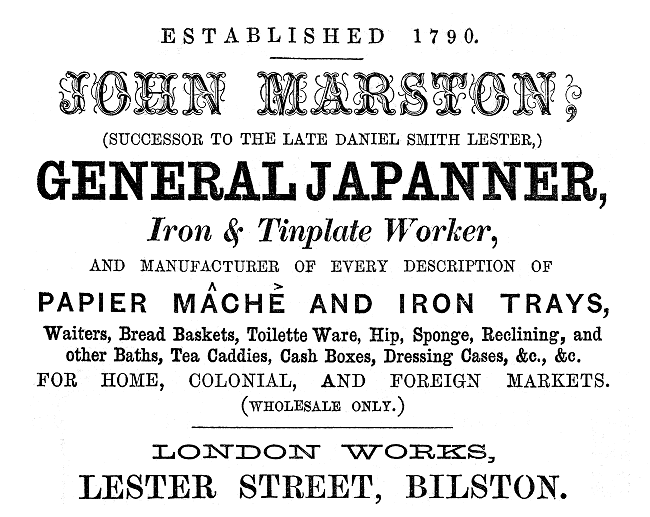
An advert from 1861.
|
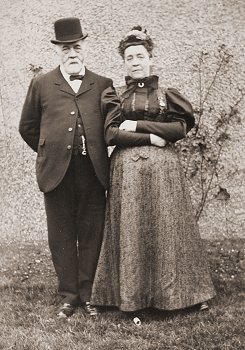
John and Ellen Marston. Courtesy of
the Marston Wolverhampton Heritage Trust archives. |
Little is known about Daniel Smith Lester and his business.
It is listed in White's 1851 History and Gazetteer of
Staffordshire under Japanners, Tin Plate, and Iron Plate
Workers, and was situated in Lester Street, Bilston.
Frederick Walton & Company was based in the Old Hall works,
and was started by his father Benjamin.
In 1865 John married
Ellen Edge, the second daughter of Charles Edge of
Edgbaston, Birmingham. She was seven years his junior. They
were to have 10 children:
Edith, born 23rd January,
1866; Charles, born April 6th, 1867; John Harold
(Jack), born 29th September, 1868; Katherine Maud, born 27th
July, 1870; Roland, born 2nd March, 1872; Ida Margaret, born
27th September,
1873; Frederick Milward, born 8th September, 1875; Norman,
born 4th September, 1879; Henry
Clive, date of birth not known; and Ellen Allerton, born
27th
December, 1886.
Unfortunately two of
the children, Edith and Henry Clive died at an early age,
and John and Ellen were to outlive several of the others. |
|
John’s business
prospered, and in 1871 he purchased
Edward Perry's Jeddo works, after Perry's death in 1869.
John became one of the major
manufacturers of japanware in the town.
John and Ellen lived
at the Oaks in Merridale Road, a beautiful Victorian house
with a large garden, which in those days was on the
outskirts of the town.
Ellen’s elder sister Fanny married
Frederick Milward of Redditch, whose family owned the large
needle making company Henry Milward and Sons, Limited,
Birmingham. Her brothers were prominent architects and
lawyers in Birmingham. |
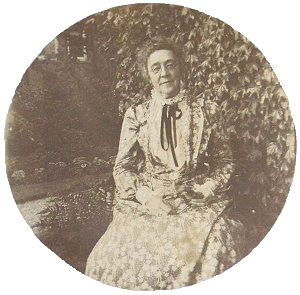
Ellen Marston. Courtesy of the Marston
Wolverhampton Heritage Trust archives. |
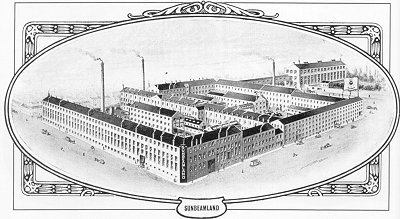 |
Sunbeamland from the 1914 Sunbeam
catalogue. Paul Street is at the front and Pool Street is on
the left. The original Jeddo works were in the courtyard
just behind the buildings on the left. |
| In 1877 Jeddo works were extended
into Paul Street. The product range included bread dishes,
dish covers, pots, pans, kettles, spirit lamps, foot warmers
and black enamel ware. John even invented a machine for
melting snow, but it was not successful.
The company became one of the two
largest makers of black enamelled ware in the country. |
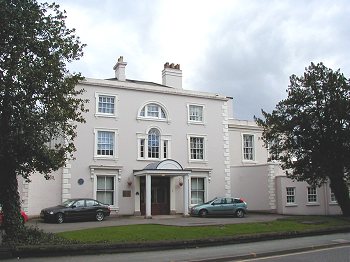
The Oaks, the family's Wolverhampton home. |
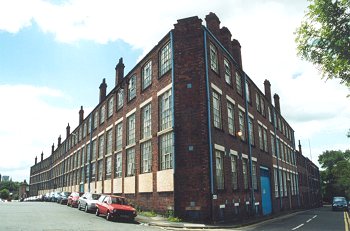
Sunbeamland today. Sadly the building
is now empty and in a state of disrepair. Hopefully this
situation will soon change. |
John became a member
of the School Board in 1882 and was chairman in 1886, 1887
and 1888. In 1885 he became a local councillor for St.
Paul's ward, where Jeddo works were situated.
John and Ellen’s
eldest sons Charles and Jack both went to Wolverhampton
Grammar School. Jack was considered to be the clever one.
When he left the grammar school he obtained a degree at
Merton College, Oxford and became a barrister. Unfortunately
his life came to an early end when he died of an incurable
disease in his early forties. |
|
After leaving the
Grammar School in 1885, at the age of 18, Charles entered
his father’s business as an apprentice. A practical approach
to chemistry was considered to be an essential part of his
training and so he attended a part-time chemistry course at
Mason College, which is now part of Birmingham University.
At the time he kept a diary and recorded each day’s events:
After arriving at
the factory with his father, he spent each morning on
clerical duties such as invoicing and then caught the 11.38
train to Birmingham for his chemistry class.
On reaching Birmingham he would have lunch with friends at Pattison's or
Benson's, and after the lecture caught the 1.40 p.m.
North Western train back to Wolverhampton.
On arrival at the
factory he worked in the dispatch department, sending off
the orders and would arrive home at about 6 o'clock. After
tea he usually had a singing lesson, practiced the organ, or
played whist with two of his sisters, and sometimes with a
visiting cousin. |
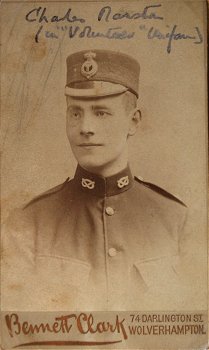
Charles Marston. Courtesy of the
Marston Wolverhampton Heritage Trust archives. |
|

Members of the staff at Sunbeamland.
2nd from the left is
Roland Marston, Charles is on the right. Courtesy of the Marston Wolverhampton Heritage Trust archives. |
Each Sunday started with a Sunday
school class at 10 o’clock followed by the regular morning
service. There would be another service in the evening.
Charles taught at the Sunday school at
St. Jude’s Church and also acted as a lay reader during
church services.
He took this very seriously and
started making a study of the Bible, which was an important
influence throughout his life. |
| The family often went out for a day
with the ladies riding in a carriage and the gentleman
riding on cycles and tricycles. They had a summer house at
Colwyn Bay, North Wales were they spent as much time as
possible each summer.
The Marstons were keen cyclists and
Charles records a trip he took with Jack to Colwyn Bay on an
August Bank Holiday. The two boys rode the 115 miles or so
from Wolverhampton to Colwyn Bay at an average speed,
including stops, of just over 8 miles an hour. They left
Wolverhampton on their tricycles at 5.58 a.m. and reached Shifnal in just over one hour in the face of a strong wind,
which would remain against them for the first 60 miles. By
8.55 a.m. they had reached Shrewsbury where they had
breakfast and exchanged tricycles. They left Shrewsbury at
9.30 a.m. and felt “utterly done up” during the last three
miles to Llangollen. Once there they had a good dinner with
brandy and water at the Hand Hotel where they recuperated.
The pair then went on to Corwen and a short stay in the Owen
Glendower, followed by a 12 mile hill climb in the face of a
strong wind that led them to Pentrevolas. Once there they
had a good tea and speeded down hill to Llanrwst, where
after another drink they went on to Colwyn Bay, arriving
there at 9.25 p.m. |
| In his diary Charles mentions that
his father was a champion tricyclist and described one of
his journeys: "'Papa' who was a champion tricyclist all his
life, started from Merridale Road at 9 a.m. on a spring day,
cold with showers, to cycle to Ludlow, 34 miles distant.
After stopping for lunch he arrived there at 3.30 p.m. in the
afternoon, sending a telegram to his family to announce his
safe arrival. Staying the night with relatives he rode on to
Shrewsbury the following day, a further 28 miles, returning
from Shrewsbury to Wolverhampton by train." He was well into
his fifty's at the time. |
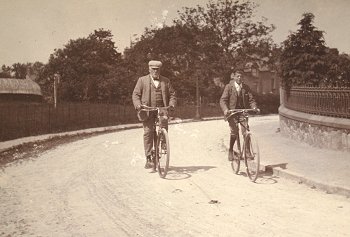
John Marston and son Norman. Courtesy
of the Marston Wolverhampton Heritage Trust archives. |
| Charles also tells of a family outing
to Shropshire one Saturday: “On a lovely, cloudless day in
July, Mother, with a friend and the five youngest children
went in the morning to Bridgnorth via Shifnal in a carriage.
The ‘wheel’ party (Peter, two friends, one a lady, Jack and
Charles) started at 2 o’clock and reached the Fox at Shipley
in 48 minutes. On arrival at Bridgnorth, we put our machines
at the Lower Town in a ‘Public’ and awaited the arrival of
the carriage party.” An aunt gave them tea and some of the
family had a look at the church. The tricycle party started
back around 7.30p.m. and reached home two hours later.
Charles mentioned that he “got up the Hermitage Hill with
two momentary stops and a slight push from Jack.”
The
Sunbeam Cycle |
|
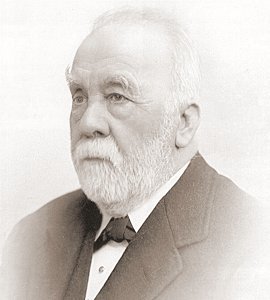
John in 1916. |
John was a strict
disciplinarian, and a hard worker who worked long hours. He
expected his workforce to do the same. He kept a close eye
on them and insisted on high standards of workmanship from
everyone. Anyone whose work was below standard would instantly
be dismissed.
The japanware
business continued to thrive until about 1885, after which
time production started to decline. Clearly something new
was required to sustain growth and John was continually
urged to consider a new product; the bicycle.
The story goes
that he discussed the matter whilst riding home from work
with Charles, and took the decision there and then to change
the direction of the business.
|
| As a keen cyclist he became
interested in trying to improve the machines of the day. In
1887 William Newill, the works foreman, built a special
cycle for John, at Paul Street. It had a low frame as John
had short legs and was finished in the usual japanning
colours of black and gold leaf, and to the usual high
standard. He was so pleased with the bicycle that he
considered manufacturing them. The story is told that John's
wife, Ellen saw the sun reflected in the high gloss finish,
and so the bicycle was called 'The Sunbeam'. The name was
registered in 1888. |
|
John initially
intended to make only tricycles, but at the time the modern
safety bicycles were all the rage and so most Sunbeam cycles
were of this type.
In the middle of
1887 he told one of his men “to draw him out an estimate of
the cost of going into the bicycle business”. This must have
been favourable because by December of that year the first
Sunbeam bicycle had been turned out at the works.
He gave William
Newill a partnership, and the company began to change
direction from making pots and pans to engineering.
The Paul Street
works first became known as Sunbeamland in 1888 and Thomas
Cureton, who had joined the company as an apprentice from
Rugby School was starting to make a name for himself at the
works. He would go on to become John’s right-hand man. |
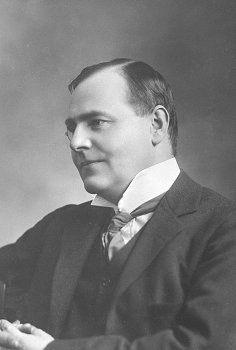
| Charles Marston.
Courtesy of the Marston Wolverhampton Heritage
Trust archives. |
|
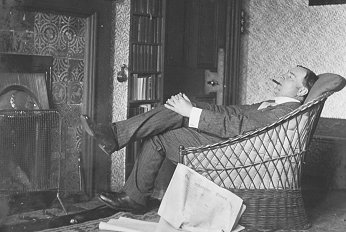
|
Charles relaxing. Courtesy of the
Marston Wolverhampton Heritage Trust archives. |
|
Charles reached the age of 21 in1888,
and a big celebration followed. The day began with letters
and telegrams of congratulation.
His presents included a cheque for £10, a
pair of gold cuff links, a gold tie pin, and a silver fitted
Gladstone bag.
At the works 3 fire balloons were let off and
a lot of explosions made with iron dies. The flag was flown
from the new flagstaff and many congratulations were given.
|
| In the evening a dinner
was held in his honour at the Star & Garter Hotel, with all
of the work's employees as guests, as well as many friends.
At the time there were just under 200 employees.
Mr. Underwood's string band played and
much wine was consumed. After the meal the tin plate foreman
presented him with an inscribed gold chronometer, and
another member of staff presented him with a decorated
bible.
It was a very enjoyable evening for
all. Charles’ apprenticeship was now over and from then on
he would receive a salary from the company, initially of £8
a month, soon followed by an increase to £15 a month. |
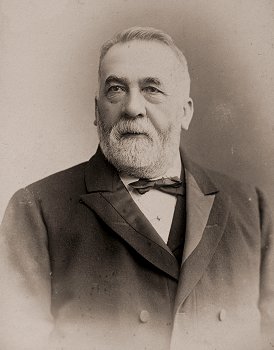
| John Marston. Courtesy
of the Marston Wolverhampton Heritage Trust
archives. |
|
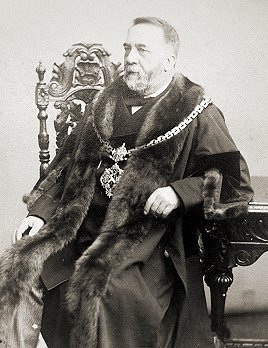
| John in his mayoral
robes. Courtesy of the Marston Wolverhampton
Heritage Trust archives. |
|
In 1889 the Marston's celebrated
their silver wedding anniversary and in November of the same
year John became Mayor of Wolverhampton, and retained the
position the following year.
During his time as mayor we worked hard with a number of
committees including the Sewerage Committee and the
Waterworks Committee to improve sanitation in the town.
Thanks to his efforts the Sewerage Committee obtained
compulsory powers to purchase land for the much needed
extension of the waterworks at Barnhurst Farm and the
Waterworks Committee arranged the completion of the much
needed water pumping machinery by the building of a set of
duplicate condensing engines.
Each engine was capable of
lifting four million gallons of absolutely pure water per
day. This ensured the reliability of the supply should one
of the machines break down. |
|
During his mayoralty
the Royal assent was obtained to empower the council to
build a power station to supply electricity for electric
lighting throughout the borough. John also became chairman
of the Finance Committee after Alderman Thorne’s retirement
and presided over the difficult and delicate negotiations
with Staffordshire County Council for a fair adjustment of
the finances after the passing of the Local Government Act
of 1888, by which Wolverhampton became a County Borough.
On the occasion of
his silver wedding the members of the council presented John
with a handsome silver plate in celebration of the event and
also to show their appreciation for his services to the
council.
On his retirement as
mayor in 1891, he was appointed an Alderman of the Borough,
and a member of the County Commission. He continued for many
years in his position as chairman of the Waterworks
Committee and was instrumental in ensuring an adequate water
supply to Wolverhampton for the years to come. At the time
the town’s population was greatly increasing and extra wells
were required. The Council twice applied to Parliament to
sink wells at Stableford and Hilton and each time the Bill
was rejected. Undaunted, the Water Committee arranged the
construction of large filters at Cosford, close to Cosford’s
River Worfe, so that water from the brook could be purified
and added to the existing supply. The river water was passed
through Jewell Rapid Filters, sterilised and mixed with the
water from the boreholes and artesian wells.
| Read about the
Water Committee and their achievements |
 |
John also served on
other municipal committees including the General Purpose
Committee, the Watch Committee, and the Distress Committee.
He was also a Justice of the Peace.
In 1900 John, Ellen and their family
moved to "The Gables" in Wood Road, Tettenhall, where the
Nuffield Hospital stands today. The house was originally
called "Glen Bank" and is believed to have been built in
around 1865 for Samuel Small Mander and his family. Samuel
died in 1881 and his wife Mary lived there until her death
in 1900. The house had extensive grounds including woods
which went down the hill as far as Henwood Road.
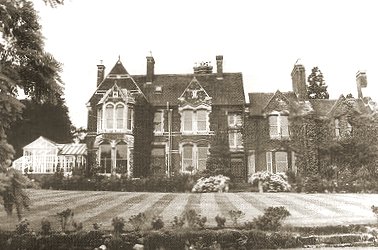 |
|
The Gables. Courtesy of the Marston
Wolverhampton Heritage Trust archives |
Back at the works |
|
In February 1889
Sunbeams were exhibited at the Stanley Show. There were 13
bicycles and tricycles on display, including J. Harrison
Carter's Oil Tight Chain Lubricator & Gear Cover Chaincase.
This was an important discovery for Sunbeam, which became an
important feature of their bicycles, and later their
motorcycles.
In 1889 a showroom
and depot was opened at 38 Holborn Viaduct in London,
followed by three more depots in 1895. Also that year the
business was incorporated as John Marston Limited. |

| The Marston family.
Left to right: Louise, Jack, Norman, John
(seated), Katie, Roland, Ellen (seated),
Charles, Marguerite, Ida, and Fred (seated).
Courtesy of the Marston Wolverhampton Heritage
Trust archives. |
|
|
Sales rocketed
and there was an urgent need for expansion, particularly
in the supply of components such as pedals. As room
could not be found on the existing site, John purchased
a factory in Villiers Street belonging to Edward
Bullivant, a tinner and japanner. He set up a new
company in the factory, called the Villiers Cycle
Components Company. It was founded in July 1898 to make
pedals and cycle components for Sunbeam, with Charles
Marston in charge. Charles had previously been on a
sales trip to America, and while there he visited Pratt
& Whitney of Hartford, Connecticut. After discussions he
returned with patterns of pedals, and the necessary
machinery specifications for making them.
A catalogue,
issued by John Marston Ltd. from their Paul Street
works, in 1896, is for "Koh-i-noor Letters and Artistic
Advertising". These appear to have been individual
letters and complete signs made in copper. Nothing
else is known about these products but they serve to
show Marston's willingness to take up a variety of
business opportunities. The project was doubtless
short lived and probably abandoned when the japanning
business was sold.
|
 |
View the Koh-i-noor
catalogue |
Whilst in America Charles met Louise
Johnson of New York City. He went to America several times
to visit her and they were married at All Souls Episcopal
Church, New York, on January 30th, 1895. On their return to
Wolverhampton they moved into a new home at Penn called
'Highfields'. Three years later they had a daughter called
Marjorie, and moved to a larger house in Tettenhall Wood,
which Charles called 'Afcot'.
Sunbeam
Cars
John was always a
perfectionist and his bicycles were finished to the highest
standard. In 1899 he experimented with his first prototype
car, built to a specification drawn up by himself and Thomas
Cureton. The car was purely experimental and most of the
parts were made at Sunbeamland or machined there from
locally made castings. The vehicle was built by Henry
Dinsdale of the Villiers Cycle Components Company and some
of his staff in a disused coach-house in Upper Villiers
Street, to a fairly conventional design with a 6 hp. single
cylinder engine, two speed gear and belt drive.
On completion a road
test was organised. Dinsdale favoured the hilly route from
Wolverhampton to Bridgnorth, whereas Cureton decided on a
journey from Wolverhampton to Stafford which was flat and
included railway stations if necessary. They travelled at
14 mph., a speed that they carefully kept hidden from John
Marston. |
|
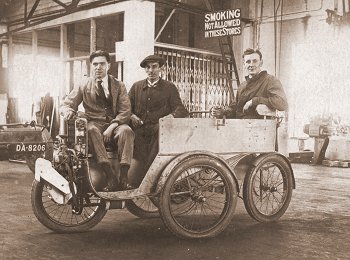
A Sunbeam Mabley. Courtesy of Jim
Boulton. |
A second, similar
car was produced in 1900 and exhibited at the Crystal Palace
Show in 1901, in company with another prototype car designed
by Mr. Maberley Smith. He offered his car to Sunbeam as a
way for them to enter the car market without any development
costs and the Sunbeam Mabley was born.
In 1902 the
remaining metalware and japanning part of the business was
sold to Orme Evans & Co. to enable Sunbeam to concentrate
solely on vehicle production. |
| The cars sold quite well and so it
seemed necessary to re-equip part of the works to expand
production, but because of the financial pressures this
caused, the decision was taken to turn this part of the
business into a separate company.
In March 1905 the Sunbeam Motor Car Co.
Ltd was formed with a starting capital of £40,000 and John
Marston as Chairman. Cars were made at Moorfield Works, off
Villiers Street and there were satellite factories at Owen
Road, Temple Street, and Ablow Street, where amongst other
components car radiators were made.
Sunbeam Motorcycles
During 1903 and 1904
John Marston and his sons were experimenting with
motorcycles. It is thought that they were using a Swiss
“Motosacoche” engine mounted on a modified Sunbeam bicycle.
Some of the Sunbeam employees were clearly giving thought to
motorcycle production because in 1903 James Morgan, the
Deputy Works Manager patented a “Little Oil Bath” for chain
driven motorcycles. The experimental work came to an end in
1904 when one of the company’s employees was killed on one
of the experimental prototypes. After the accident John
Marston decreed that no more work would be carried out on
these machines in his factory. It seems that he never liked
them in the first place. |
|
John’s aversion for
motorcycles continued for several years, during which time
much of the early development had taken place and many
successful machines were manufactured locally. His thoughts
eventually turned back to this direction in 1911/1912 and he
engaged John Greenwood who had previously worked for Rover
and JAP to develop a Sunbeam motorcycle.
The best local
motorcycle designer was Harry Stevens, one of the four
Stevens brothers who ran A. J. Stevens & Company Limited,
just up the road in Retreat Street. Harry would later become
well known for his A.J.S. motorcycles that were produced in
vast numbers at Graiseley Hill.
Harry was employed by
Sunbeam as a consulting engineer and he designed the first
Sunbeam motorcycle, a 349 cc. single cylinder side-valve
machine, with two speed transmission and a forward magneto.
John Greenwood then had the task of preparing it for
production. He only made two major modifications which were
to place the magneto behind the cylinder and to change the
drive system. The first machines went into production in
1912 and were soon a great success and would eventually
overshadow the company’s bicycles. They became known as “The
Gentleman's Motorcycle”. |
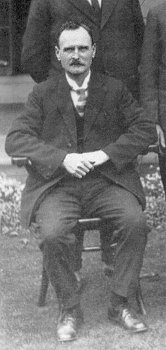
Harry Stevens. |
| One of John and Ellen's daughters, Ida, married
Edward Deanesly who became one of the leading surgeons
at the Royal Hospital in Wolverhampton.
They initially lived in Waterloo Road, before moving
to 'Claremont' on Penn Road.
One of their sons, Christopher, who can be seen in
the photograph below as a child, was awarded the D.F.C.
for his work as a pilot in World War Two.
In the Battle of Britain he was shot down twice, and
rescued from the Channel on each occasion. |
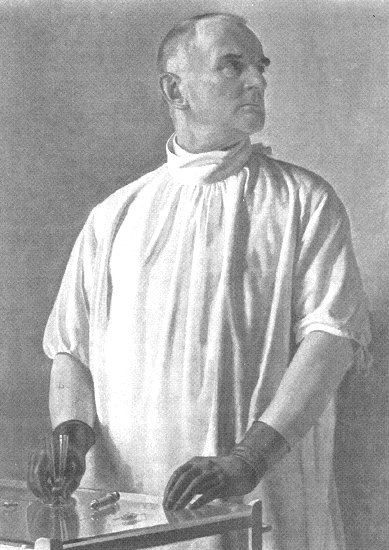
Edward Deanesly |
 |
Ellen Marston at home with her
grandchildren in 1914 at their last home in Wolverhampton;
"The Gables". Left to right:
Melissa Marston, Joyce Deanesly,
Christopher Deanesly, John Marston junior, Ellen, Marjorie
Marston, Dick Deanesly, Pat Marston (on the floor), Ruth
Deanesly (rear), Brenda Marston, Diana Deanesly.
Courtesy of the Marston
Wolverhampton Heritage Trust archives. |
|
John continued to
ride his cycle and used it as his personal transport to
work. Each morning an employee in uniform would set off to
the Chairman's house, riding a cycle and propelling the
Chairman's machine by hand. On arrival at the Oaks, the
employee would hand over the cycle and John would mount his
machine and set off for the works. The employee would follow
behind at a discrete distance. John also liked a Reynolds
currant bun with his morning tea, and so each morning an
employee would walk to Reynolds Restaurant in Queen Square
and collect one for him.
In 1901 John was elected chairman of
the governors of the Grammar School, and became an Honorary
Freeman of the Borough on 14th October, 1909. He was also a
member of the Board of Management of the Wolverhampton and
Staffordshire General Hospital, and became its chairman on
the death of Mr. A. C. Twentyman. He held the position until
1909.
John also became a member of the
Wolverhampton Chamber of Commerce, and the first president
of the Wolverhampton Automobile Club. He was a staunch
supporter of the Conservative Party and became president of
the West Wolverhampton Conservative Association, and
chairman of the Wolverhampton Conservative Club.
After attending St. Mark's Church for
many years he became a regular worshiper at Christ Church in
Tettenhall Wood when the family moved to "The Gables". John
was also a Freemason and a member of the Lodge of Honour.
He finally retired
in 1916 at the age of 80, but his retirement was to be
short-lived. Two years later John and Ellen were resting at
their house in Colwyn Bay when they heard some terrible
news. Their third son Roland had died suddenly at the age of
45. It was planned for Roland to succeed John as Chairman of
the company. John had outlived five of his children, but the
shock of Roland's death was too much. John and Ellen went to
Roland's funeral on Thursday March 7th, 1918, but grief
stricken John died the next day at around 9 p.m. at Colwyn
Bay. Ellen died six weeks later, also from grief.
John and Ellen were
buried at Colwyn Bay, and not Wolverhampton, for reasons
connected with the war, possibly transportation problems. A
public service was held in Wolverhampton for the man who had
done so much for the town, and had brought much employment
to the area. A commemorative tablet was erected at St.
Peter's Church by the employees of the company.
The location of John and Ellen's grave has recently been
discovered by Angela and Trevor Davies after some clever
detective work. It is in Saint Trillo's Church graveyard,
Llandudno Road, Rhos-on-Sea. |
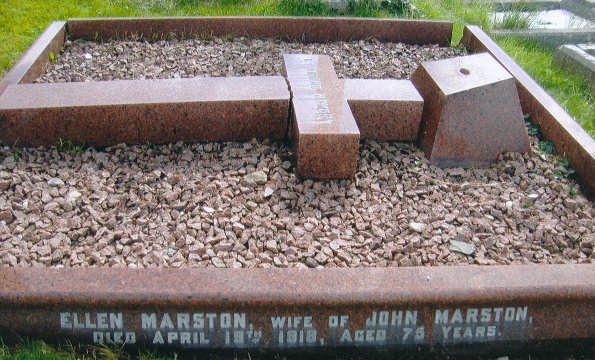
John and Ellen's grave. Courtesy of Angela and
Trevor Davies.
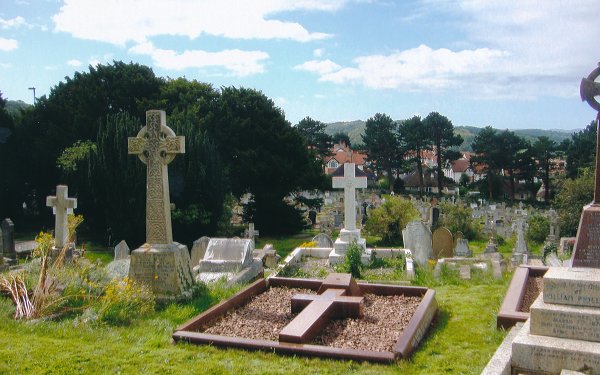
Another view of the grave. Courtesy of Angela
and Trevor Davies.
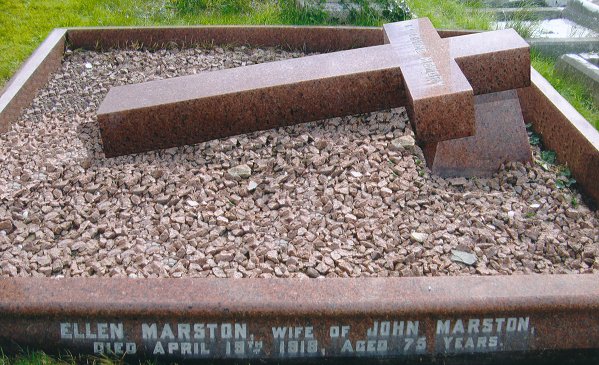
This is a reconstruction to show how the grave
originally looked.
| After facing a claim for death
duties, Charles sold his shares in John Marston Ltd to a
number of wartime munitions manufacturers.
Charles was interested in archaeology and
had become an enthusiastic archaeologist. He was a member of
the Shropshire Archaeological Society and became very
interested in Roman Britain. 1921 was a tragic year, as
Louise died after a long illness, in an American nursing
home near New York.
Charles married again the following
year. His new wife was Ruth Miller Bayne, an old family
friend, also from America. She had a daughter, Margaret from
a previous marriage. Charles was heavily involved with the
Conservative Party and received a Knighthood in 1926.
He was
elected for the diocese of Lichfield as a member of the
House of Laity of the Church Assembly, and remained a member
for twenty years. He wrote a number of archaeological books
on excavations in Palestine, and visited the country with
Ruth on a number of occasions. |
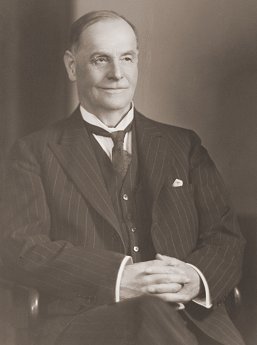
| Charles in later life.
Courtesy of the Marston Wolverhampton Heritage
Trust archives. |
|
|
They moved to a new
home called 'Elmdene', at Camden Park, Tunbridge Wells.
Sadly Ruth developed breast cancer in 1933, and died a short
while later. She is buried in the family's grave at
Tettenhall.
In 1935 during
another visit to America, he met and married his third wife,
Mary Battey Bonney from Atlanta, Georgia. After the marriage
they went on a trip around the world. They returned to
Tunbridge Wells and stayed there until 1940, after which
they moved to Stratford-on-Avon, to avoid the air raids that
were taking place at the beginning of the war. Charles died
on May 21st, 1946 at the age of 79.
Other Marston family graves can be
found in the graveyard at St. Michael and All Angels Church,
Tettenhall.
|
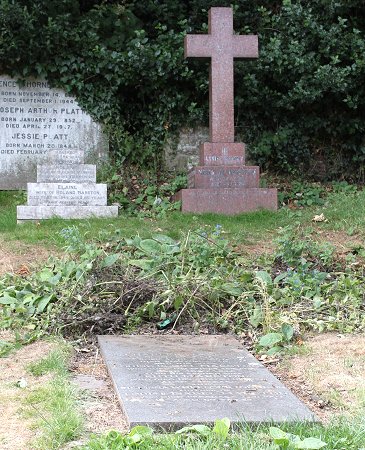 |
The Marston family's graves at St.
Michael and All Angels.
Charles' grave is in the foreground with Roland, and his
wife Elaine's grave behind on the left. Behind on the right
is Norman and John Harold's grave.
The inscription on Roland and
Elaine's grave is as follows:
Sacred to the dear memory of
Roland, husband of Elaine Marston. Died February 28th 1918.
Aged 45 years. Peace Perfect Peace.
Elaine, wife of Roland Marston.
Died February 18th, 1949. Aged 65 years. Peace Perfect
Peace. |
| The inscription on Norman and John
Harold's grave on the right is as follows:
In Loving Memory. Norman Marston.
January 3rd 1906. Aged 26 years. Son of John and Ellen
Marston of Tettenhall.
Also of John Harold Marston.
October 3rd 1912. Aged 44 years. |
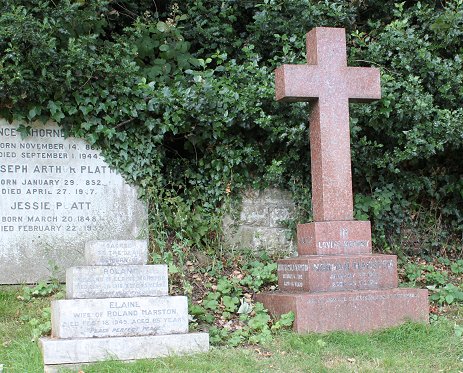 |
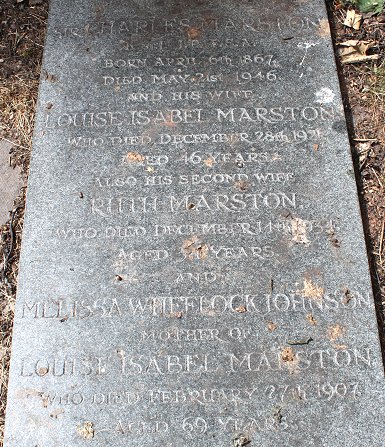 |
The inscription on the final grave
reads: Charles Marston
Born April 6th, 1867 Died May 21st,
1946.
And his wife Louise Isabel Marston
who died December 28th, 1921 aged 46 years.
Also his second wife Ruth Marston
who died December 14th, 1934 aged 34 years.
And Melissa Wheelock Johnson mother
of Louise Isabel Marston who died February 27th 1907 aged 69
years. |
References:
Marjorie von Harten
and Melissa Marston, Man of Wolverhampton, Coombe Springs
Press.
John Jones, The
Mayors of Wolverhampton, Volume 2, Whitehead Bros., 1893.
W. H. Jones, Municipal Life of
Wolverhampton, Alexander and Shepheard, 1903.
Robert Cordon Champ, The Sunbeam
Motorcycle, Haynes Publishing Group, 1986.
John A. Chambers, A History of "Glen Bank" or as it was
later called "The Gables", 1994. |
|